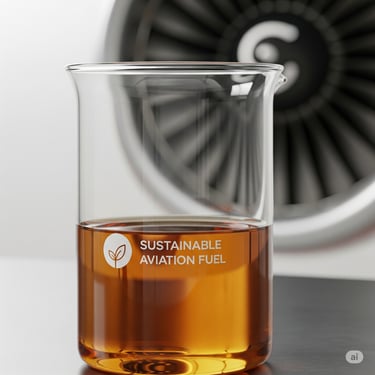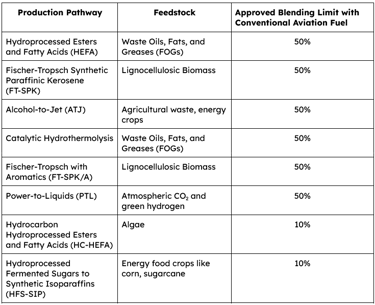Sustainable Aviation Fuel – Is It Really Essential?
You may have stumbled across the term “Sustainable Aviation Fuel” a lot these days. There are numerous debates regarding its production and the underlying science behind it. People ask – Do we really need SAF? Do we really need to invest in several production pathways for producing SAF? Is it actually aiding in reducing the overall carbon content in the atmosphere? The short answer to all of these questions is – yes!
SUSTAINABLE TECHNOLOGIES
Shreyas Joshi
7/31/20254 min read


SAF, or Sustainable Aviation Fuel, is a renewable, non-petroleum variant of aviation fuel which can be procured from various biological entities, including waste oils, fats and greases (FOG’s); agricultural waste, including wheat straw, rice husk, groundnut shells; forestry residues, including dead branches, trunks, sawdust and wood pellets; municipal solid waste, including plastics, food waste, glass, paper, cardboard, packaging materials as well as sewage sludge.
SAF wins two important points over traditional aviation fuel sourced from crude oil. First, the lifespan of SAF closes the carbon cycle much more effectively and in relatively quick time, as the biomass rapidly absorbs the carbon emitted by the combustion of SAF in their growing stage, which is not the case with petroleum, since carbon captured millions of years ago, is being released into the atmosphere with an extremely slow absorption process back into petroleum. Secondly, the carbon emitted during the combustion of SAF, produced from eight different production pathways, is relatively less than that of petroleum. For instance, carbon emissions for petroleum total around 90 gCO2eq/MJ (grams of CO2 equivalent per mega-joule), whereas SAF emits around 5-60 gCO2eq/MJ, depending on the pathway. Hence, is SAF really necessary? Yes, and that’s why!
At the current production rate, about 1 million tonnes of SAF were produced globally in 2024. Global demand for Sustainable Aviation Fuel (SAF) is projected to reach 17 million tonnes per annum (Mt/a) by 2030. Currently, eight production pathways are used to generate SAF. Of these, the HEFA (Hydroprocessed Esters and Fatty Acids) pathway accounts for approximately 80% of the total SAF produced globally. HEFA fuel is cleaner than traditional jet fuel because it contains less sulfur and fewer harmful substances. A slight problem arising here is that the HEFA pathway is much more suitable for generating bio-diesel rather than SAF, with the majority of the HEFA plants around the world focusing on producing bio-diesel, although a few plants have constructed plants solely concentrating on SAF production from HEFA. The overall pathways can be summarised as shown below:
Another pathway, Methanol-to-Jet (MTJ), hasn’t been approved by ASTM (American Society for Testing and Materials) yet, due to concerns over feasibility and a lack of consistent data. Here, biomass undergoes gasification, where it is subjected to intense temperatures of around 800-1100℃, in the presence of some gasifying agent like steam and/or oxygen in a fixed-bed, fluidized bed, or entrained flow gasifier. During this process, biomass gets converted into synthesis gas or syngas, a combination of carbon monoxide and hydrogen with small amounts of carbon dioxide as well. This syngas is then hydrogenated to generate methanol, which is a significant intermediate step in this process. This methanol is dehydrated to give lower olefins like ethylene and propylene, which undergo oligomerization (combining smaller olefin units to produce higher olefins in the range of C8 to C16, suitable for jet fuel characteristics). Olefins, on their part, cannot be a part of jet fuel, as they are reactive due to the presence of a double bond. Olefins undergo hydrogenation (combination with hydrogen) to break these double bonds and form paraffins (or alkanes). The final step is fractionation, where jet fuel is separated from other fuel mixtures. A significant amount of research is being conducted to ensure that it receives the necessary approval under ASTM 7566 and ASTM 4054.
Composition: SAFs are generally composed of linear paraffins, cycloparaffins, olefins, and aromatic compounds, in the C8–C16 range. SAF must satisfy numerous requirements, which include being non-toxic, widely accessible, having a low freezing point, significant energy density, low viscosity, fast evaporation, and better atomization, especially when compared to current Jet A-1 fuels. Cost competitiveness is a non–ASTM requirement that should also be considered. The freezing point of the fuel is a crucial property influenced by the length of the paraffinic carbon chain and the presence of iso-paraffins and aromatics.
Challenges: The main challenge remains the emergence of a market to generalise the use of SAF. There is both a demand and a supply challenge.
Cost of SAF: Even though the quantity of SAF available has increased in recent years, demand remains suppressed due to the higher cost of SAF compared to kerosene. The industry has to address this disparity and reduce the price gap with traditional fuel.
Policies and regulatory frameworks needed: SAF development and adoption are hindered by a lack of consistent and supportive policies, as well as clear and stable ones.
Availability of SAF: SAF production has increased dramatically in recent years, but SAF still accounts for a tiny portion of the globally consumed jet fuel. In the long term, significant investments in new facilities are needed to scale up production.
Availability of SAF feedstocks: Securing sustainable and scalable feedstocks from which to produce SAF is a significant challenge. Ensuring that these feedstocks do not compete with food production or negatively impact ecosystems is a key consideration that further limits the availability of viable feedstocks.
Technological Maturity: While several SAF production pathways exist, some are more nascent than others. Continuous innovation is necessary to enhance production efficiency and lower costs. The certification process can also take time.
On an ending note, it's high time for people to realise that SAF holds the key to a carbon-free future. It will be a long time before futuristic technologies like hydrogen-powered aircraft and electric aircraft emerge, as they currently face numerous feasibility issues. Till then and even beyond, SAF will ensure that the carbon emitted in the atmosphere is reabsorbed and its harmful effects negated. One advantage of SAF is that it is a drop-in fuel, which means it is compatible with existing aircraft systems and airport infrastructure, making it easier to integrate SAF into the existing global aviation system. This demonstrates the potential of SAF as a viable, low-carbon alternative to traditional jet fuel. Therefore, displaying enthusiasm in helping SAF power the ever-increasing number of flights is the only way to make the world a more sustainable and better place to live. Go SAF!
References:
https://skynrg.com/sustainable-aviation-fuel/technology-basics/#:~:text=AtJ%20converts%20alcohols%20into%20SAF,spec:%20D7566%20%E2%80%93%20Annex%205.
https://www.sciencedirect.com/science/article/pii/S2589004223010210#:~:text=Summary,equal%20weight%20for%20all%20criteria.


Connect
info@energizetomorrowus.com
© 2025. All rights reserved.


